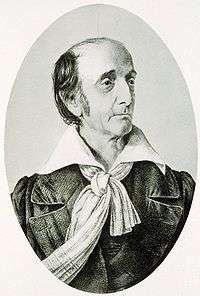Ferdinand Rudolph Hassler
| Ferdinand Rudolph Hassler | |
|---|---|
 | |
| Born |
October 7, 1770 Aarau, Switzerland |
| Died | November 20, 1843 (aged 73) |
| Residence | Switzerland, United States |
| Fields | Surveyor |
| Institutions |
United States Military Academy United States Coast Survey United States Treasury Department |
|
Signature | |
Ferdinand Rudolph Hassler (October 7, 1770 – November 20, 1843) was a surveyor who worked mostly in the United States and also in Switzerland. He headed the United States Coast Survey and the Bureau of Weights and Measures.
Biography
Hassler was born in Aarau, Switzerland. He was employed on the trigonometrical survey of Switzerland before he emigrated to the United States in 1805. He was acting professor of mathematics at West Point from 1807 to 1810. He was employed by the federal government of the United States by 1811 in an effort to begin a Coast Survey.[1] An Act of Congress on February 10, 1807 had appropriated $50,000 to pay for the beginning of the work. Afterward, he became the first superintendent of the United States Coast Survey in 1816. Two years later, the United States Congress passed the control of the Coast Survey to the army, principally, where it lingered until 1832.
Hassler became the head of the Bureau of Weights and Measures in the Treasury Department where he carried out the early work of establishing the standards of weights and measures in the United States, with the involvement of fellow Swiss immigrant Albert Gallatin, who in 1827 brought from Europe a troy pound of brass which was made the standard of mass in 1828. Besides several textbooks of science, Hassler produced a publication in 1828 titled System of the Universe in two volumes.
Hassler undertook a complete investigation of the national standards in 1830. Perhaps the most meaningful national standard to be adopted in 1830 was the gallon at 231 cubic inches. In the United States, however, each State retained the rights to employ its own set of standards of weights and measures. Since 1830, a great deal of national legislation has been enacted, with much of it addressing the acceptance or the rejection of the metric system. The United States Bureau of Standards was created by an Act of Congress on March 3, 1901.
As mentioned above, the Coast Survey languished for 14 years from 1818 to 1832. In 1823, 1824, and 1825, the Navy Department tried to establish a hydrographic office. Also, the Survey was a source of discussions in Congress, which finally passed a law on July 10, 1832 that resulted in the removal of the Survey away from the army and the navy. Hassler was appointed the superintendent of the Survey on August 9, 1832, and he served in that post until his death on November 20, 1843. The steamship owned by the Coast Survey was named the Hassler.
Ferdinand Rudolph Hassler's granddaughter, Mary Caroline Hassler Newcomb, married the much noted astronomer and mathematician Simon Newcomb. Simon and Mary Caroline Hassler Newcomb were themselves the grandparents of the also much noted professor of mathematics, Hassler Whitney.
Honors
- Elected a member of the American Antiquarian Society in 1838.[2]
See also
Notes
- ↑ Philbrick, Nathaniel (2003) Sea of Glory: America's Voyage of Discovery: the U.S. Exploring Expedition Viking Penguin ISBN 9780142004838 pg 22-23, 26-29
- ↑ American Antiquarian Society Members Directory
References
- United States Military Academy
- Cajori, Florian (1980). The chequered career of Ferdinand Rudolph Hassler. New York: Arno Press. p. 245 p. ISBN 0-405-12535-6.
- Linklater, Andro (2002). Measuring America : how an untamed wilderness shaped the United States and fulfilled the promise of democracy. New York: Walker & Co. p. 310 p. ISBN 0-8027-1396-3.
Further reading
Parr, Albert C. (January–February 2006). "A Tale About the First Weights and Measures Intercomparison in the United States in 1832" (PDF). Journal of Research of the National Institute of Standards and Technology. 111 (1): 31–40. doi:10.6028/jres.111.003. ISSN 2165-7254.
External links
- Hassler's biography at USMA Department of Mathematical Sciences
- Hassler's Dilemma from Discover Lewis and Clarc
- Ferdinand Hassler at surveyhistory.org
- History of NOAA Ocean Exploration: Early years
- F.R. Hassler Exhibition 2007
 "Hassler, Ferdinand Rudolph". Appletons' Cyclopædia of American Biography. 1892.
"Hassler, Ferdinand Rudolph". Appletons' Cyclopædia of American Biography. 1892.
| Government offices | ||
|---|---|---|
| Preceded by none |
Superintendent, United States Survey of the Coast 1816–1818 |
Succeeded by none |
| Preceded by none |
Superintendent of Weights and Measures ca. 1818–1843 |
Succeeded by Joseph Saxton |
| Preceded by none |
Superintendent, United States Survey of the Coast 1832–1836 |
Succeeded by none |
| Preceded by none |
Superintendent, United States Coast Survey 1836-1843 |
Succeeded by Alexander Dallas Bache |